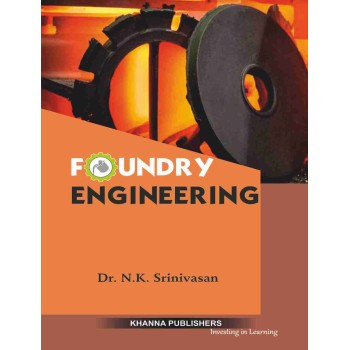| Book Detail | |
| What's special / Useful in this book | The core of the book consists of the following : - casting design (Chapter 6) - mould design (gating and risering, Chapters 7 and 8) - metallurgical principles (Chapter 5, 9 and 10). Methods of improving productivity and for reducing casting defects are emphasized at several places. Further metallurgical quality control is stressed. Brief accounts of pollution control are given at appropriate place and in Chapter 13. Empirical relations abound in foundry engineering. The present book includes only those relations that are widely employed to provide a working knowledge. As far as possible, conceptual understanding is emphasized. As in some German text books, this book has appendices at the end of chapters. The appendices provide additional information or data or extended discussion which can be omitted at first reading. To help the students with numerical calculations, worked examples are dispersed in the text. Questions and problems are included at the end of the text. S.l. units are employed. The author acknowledges the numerous sources of references consulted, as given under 'references'. He is grateful to the training and inspiration he had received from his teachers, especially Prof. A. S. Nowick (Columbia University), Dr. V. Ramachandran, Dr. K. L. Vasu and Dr. K. P. Abraham (at Indian Institute of Science, Bangalore). He is thankful to Principal, PSG College of Technology for giving permission to publish the work. He appreciates the excellent suggestions given by Prof. R. Sundararajan. He acknowledge the assistance and suggestions from M. Sundare, Ramnarayanan, P. Gopalakrishnan and S. S. Ramakrishnan. His sincere approciation goes to D. Paramasivan and C. V. Gopalakrishnan for neat typing of the manuscript and to S. Kannan of Design, Drafting Centre, Coimbatore for preparation of drawings. |
| Publication Year | 2001 |
| Language | English |
| Pages | 274 |
| Preface | |
| Preface | PREFACE TO THE FIRST EDITION Books on foundry engineering fall into two categories. In one category, there are books which describe various casting processes and give certain methods of practice. In another category, books which compile numerous data and research findings exist. The books of first category cater to the needs of beginning students. The books of second category are intended for advanced students and research workers. The present book is, however, designed particularly as a text for engineering students of mechanical, metallurgical and production branches-emphasizing basic concepts and engineering principles, as applied to casting processes. The book will also be useful for practising engineers and for training programmes in industries. |
| Table of Contents | |
| Table of Contents | Contents 1. Introduction 1.1. Advantages of Casting Method 1.2. Flow Sheet for Production of Castings 1.3. Classification of Foundries 1.4. History 1.5. Process Selection 1.6. Applications of Castings 2. Patterns 2.1. Types of Patterns 2.2. Pattern Materials 2.3. Pattern Allowances 2.4. Care of Patterns Plastic Patterns 3. Moulding and Core Making 3.1. Sand Casting 3.2. Permanent Mould 3.3. Die Casting 3.4. Plaster Mould 3.5. Investment Casting 3.6. Ceramic Mould 3.7. Full-mould Process 3.8. Centrifugal Casting 3.9. Squeeze Casting 3.10. Cores and Core Making Appendix -1 Speed of Revolution for Centrifugal Casting 4. Foundry Sands 4.1. Moulding Sand 4.2. Core Sand 4.3. Binders 4.4. Sand Additives 4.5. Natural and Synthetic Sands 4.6. Parting Compounds, Mould and Core Wash 4.7. Sand Testing 4.8. Sand Control 5. Solidification of Metals 5.1. Structure of a Pure Metal 5.2. Solidification of Alloys 5.3. Structure-Property Relationships 5.4. Characteristics of Liquid Metals 5.5. Inoculation and other Treatments 5.6. Hot Tearing 6. Casting Design 6.1. Minimum Section Thickness 6.2. Principle of Directional Solidification 6.3. Hot Spots, Junctions, Ribs and Bosses 6.4. Hot Tears and Cracks 6.5. Design for Moulding 6.6. Design for Core Support 6.7. Design for Cleaning 6.8. Design for Machining 6.9. Cast-Weld Construction 6.10. Design Stages 6.11. Guidelines for Economical Production Appendix-6.1. Design details for steel Castings Appendix-6.2. Core Support Appendix-6.3. Cored holes Appendix-6.4. Boss height Appendix-6.5. Machining features Appendix-6.6. Inserts of different metals Appendix-6.7. Dimensional Tolerance Appendix-6.8. Dimensional Accuracy for Pressure Die Casting Appendix-6.9. Surface finish of Casting Appendix-6.10. Machining allowances for Castings Appendix-6.11. Dimensional accuracy Appendix-6.12. Cast alloy selection 7. Riser Design 7.1. Riser Design Parameters 7.2. Types of Risers 7.3. Riser Locations 7.4. Riser Shape 7.5. Riser Calculations 7.6. Feeding Distance 7.7. Riser Neck 7.8. Use of Chills 7.9. Padding 7.10. Insulating and Exothermic Materials 7.11. Tapered riser 7.12. M.C. method for riser design 7.13. Riser design with insulation Appendix-1 Volumetric Contraction Appendix-7.3. Pribyl formula for riser size Appendix-7.4. Tapered Riser Design 8. Gating System 8.1. Objectives 8.2. System Components 8.3. Types of Gating 8.4. Basic Principles 8.5. Gating Calculations 8.6. Gating Ratio 9. Cast Metals 9.1. Ferrous Alloys 9.2. Copper and its Alloys 9.3. Aluminium and its Alloys 9.4. Magnesium Alloys 9.5. Zinc Alloys 9.6. Nickel Alloys 10. Melting 10.1. Melting Furnaces 10.2. Cupola 10.3. Melting Practice 10.4. Ladles and Pouring 10.5. Shake-out Operation 11. Cleaning and Inspection 11.1. Cleaning of Castings 11.2. Inspection 11.3. Radiography 11.4. Mechanical Testing 12. Casting Defects 13. Mechanisation, Automation and Pollution Control 13.1. Approach to Mechanisation 13.2. Foundry Equipment 13.3. Materials Handling Systems 13.4. Automation 13.5. Pollution Control 14. Foundry Production Aspects 14.1. Introduction 14.2. Selection Criteria 14.3. Selection of Process 14.4. Metal Utilisation 14.5. Energy Utilisation 14.6. Labour Utilisation 14.7. General Economy Measures 14.8. Casting Costs 14.9. Scale of Operations 14.10. Productivity- Enviornmental and Health protection Questions and Problems Appendix-I Hand Moulding Tools Appendix-2 Hot Blast Cupola Appendix-3 Relative Machinabilities of typical alloys Appendix-4 Recommended minimum wall thickness of cast metals Appendix-5 Operating Voltage range X-ray radiography Appendix-6 Foundry Layout Appendix-7 Quality Control in Foundries |
Tags: Foundry Engineering

